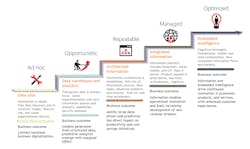Advancing Information Transformation in the Manufacturing Industry
Manufacturers depend on information and analytics to help them deal with the complexity caused by global operations, value chains and market. Most recognize that there is tremendous opportunity to use, analyze and apply information all across the business. However, they need to do a better job capitalizing on the information that is and will become available to them and to embed intelligence in how they manage their operations and deliver products and services.
Manufacturers must evolve from a classic data management approach to one that leverages information and knowledge as critical business assets. Existing quality, data governance and data management practices are still essential. But these practices must evolve to meet the requirements both of the legacy environment and of the digital business under construction.
Information transformation is a huge and critical challenge for many. IDC estimates that by 2020, the digital universe will reach 44ZB, or 44 trillion gigabytes, of data—a tenfold increase over that in 2013, with 40% growth per year. To make matters worse, IDC estimates that 22% of the information in the digital universe was usable for analysis in 2013; however, less than 5% of that usable information was analyzed. These numbers need to change for manufacturers.
Although most manufacturers have aggregated and analyzed much of their transactional data, many see value in other data types and sources, such as machine- or sensor-generated data, GPS data, text, rich media (image, voice and video), and consumer sentiment from e-commerce sites and social networks.
The Rise of the Knowledge Worker
Manufacturers need their employees to do their jobs more efficiently and productively—as they manage operations, design products and develop new intellectual property (IP)—from anywhere in the world. Knowledge is the basis for augmenting and automating work throughout the company and from the experienced to the new generation worker to yield further productivity benefits.
Knowledge workers—those employees who primarily rely on data and information to do their work—currently represent about 40% of the manufacturing workforce. And in large or geographically dispersed manufacturers, information is often the glue that keeps the company working as one. Yet manufacturers often struggle to provide unified information access systems with a “single point of access” to heterogeneous data sources or achieve what we call “truth in data.”
Data-Driven Manufacturing—In Processes and Products
Despite all of the localized information analysis that takes place today within various lines of business or applications, manufacturers are still not achieving the success they would like to in applying that information, whether because of data quality problems, data disconnects, the age or timeliness of the data, or even the availability of data.
Some of the use cases that are currently receiving the most interest leverage sensor data, create new products and services, and change how manufacturers interact with their customers and their customers’ customers. But most of these new use cases require the integration of enterprise data sources and external data sources (such as weather and traffic). This is especially true for two use cases that are of high interest to many manufacturers:
• Predictive asset maintenance uses sensor data on production equipment, integrated with enterprise asset management systems to drive maintenance and with inventory data to ensure an adequate supply of necessary service parts.
• New service delivery via connected products uses sensor data in products in use by customers to monitor real-time product performance data for maintenance, to confirm products are under warranty, or to deliver consumables. Integration bridges sensor data, warranty systems, CRM, ERP and supply chain applications.
Eventually, we will also find manufacturers selling their data as a product, and although we don't fully know how this market will develop, it builds on the fact that “knowledge is power.” 3-D printing and robotics will also contribute to data-driven manufacturing as well, both requiring a significant amount of data to fine-tune their performance and generating large volumes as they operate.
Changing Technology—Business Process Platforms and Advanced Analytics
Other factors are driving the need for information transformation, such as the need to support business processes and interdepartmental collaboration that crosses application boundaries. For example, the global product innovation platform, which serves as a way to increase access to and sharing of product-related documents and data for distributed engineering organizations and well beyond engineering. Data integration and analytics are absolutely essential to the successful implementation of the innovation platform and other process platforms.
The availability and demand for more advanced analytics are also accelerating, as manufacturers look to the promise of prescriptive analytics, machine learning and cognitive computing to provide guidance or even automation.
Information Transformation
Manufacturers must do more than just invest in tools and technologies; they need an information transformation. Such a strategy can help manufacturers advance and draw maximum benefit from the extraordinary power of information. In each stage of this transformation, leaders should focus on the following dimensions:
Data discovery: including acquisition and preparation, exploration, visualization and datafication.
Value development: through analytics, algorithms, program management and quality.
Value realization: through monetization, productization, real-time orchestration and service innovation.
Knowledge and collaboration: including work virtualization, knowledge and integration, governance, and risk.
Information architecture: including data management and enterprise information model, integration and synchronization, information archtecture services, and security.
At the highest level of maturity—the optimized stage—organizations will be able to drive continuous improvement in how data value is developed and realized throughout the value chain. They will rely on an information platform that ensures the security of the company’s IP and clearly establishes information as an essential corporate asset. They also will value their data and even monetize it.
Information and embedded intelligence drive continuous innovation in processes, products and services; enable revenue streams; and fuel enhanced customer engagement and experiences.
Our guidance for manufacturers over the next year includes:
• Assess your enterprise capability in each of the dimensions of an information transformation.
• Adopt a balanced scorecard approach to coordinating initiatives and interdependencies across the dimensions. Our research indicates that imbalance across the maturity levels impedes success.
• Lead by example and champion collaboration. Allow both top-down and bottom-up actions to positively interact. Educate all the stakeholders.
• Treat data and information as you would any critical business asset. This means measuring, documenting and managing essential attributes such as value, risk and cost.
• Focus on meaningful but limited initial initiatives before investing in larger ventures. Agree on maturity targets and create the roadmap of your information digital transformation.
The most advanced companies can accelerate the pace of sophisticated analysis, the mix of data and data types, and the ability to optimize and predict business decisions. Leaders in information transformation will treat data and information as they would any critical business asset—with investments in people, processes and technologies that acknowledge information’s strategic importance and with a roadmap to maximize information’s contribution to business success.
Kimberly Knickle is research vice president with analyst firm IDC Manufacturing Insights. IDC's MaturityScape for information transformation helps business and IT leaders assess their information capabilities and stage of maturity; understand the challenges and opportunities; identify areas of needed improvements; and create the road map and the framework to move forward.





